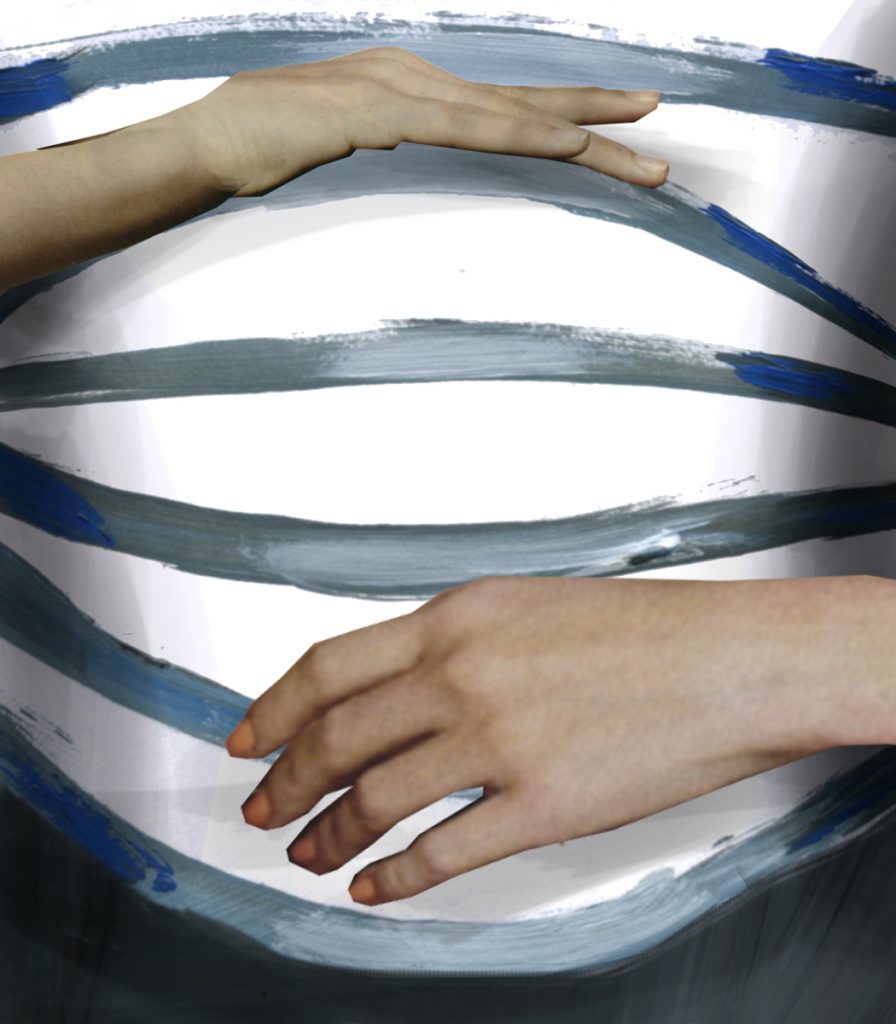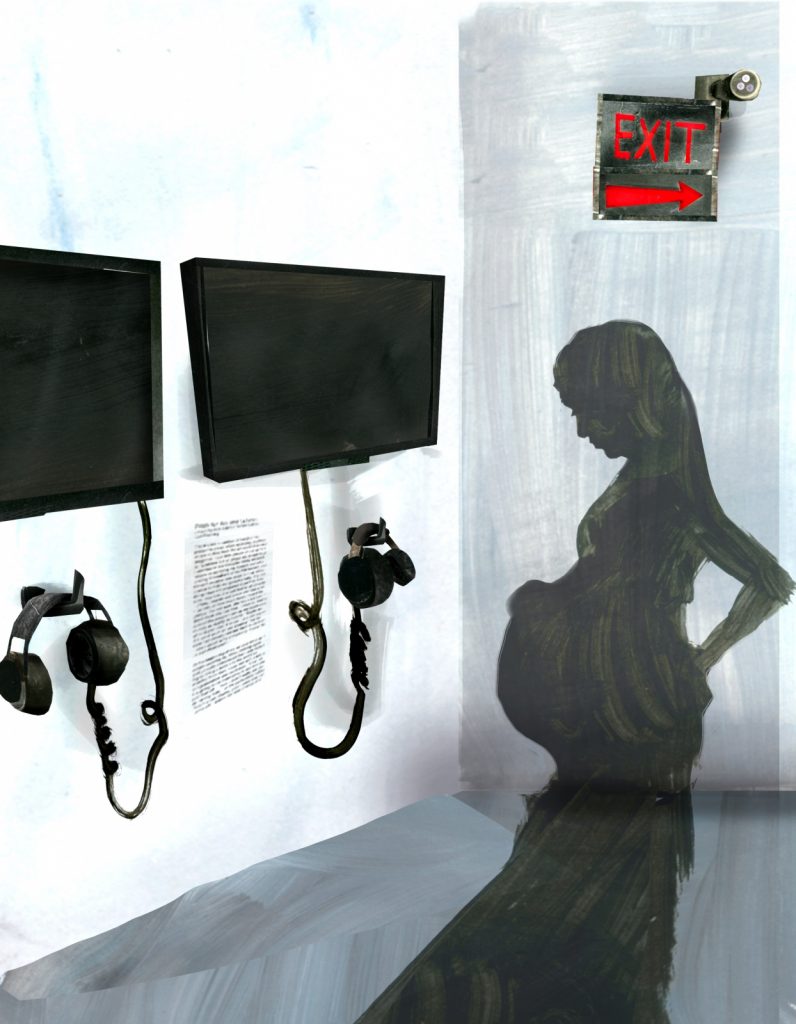
I expected to cross a number of hurdles during the fourteen weeks I spent hiding my pregnancy from the art world. For instance, I put little pieces of cut-up lime on the rim of tumblers of ginger ale at openings. I vomited in the Cineplex lobby seconds before re-applying my lipstick and introducing filmmakers at the Atlantic International Film Festival. I found creative new ways to wear office basics to hide my growing belly. However, I had not prepared myself for how it would feel to sit on committees, boards, and juries while taking a private tally of how many times I heard I’m not sure, she has a kid now. I don’t think she has time. I tried my best to subtly defend the artists I saw as my future community, but the idea had already planted itself in my brain: was I about to be completely discounted as a professional?
During the nine months of my pregnancy, I programmed for three film festivals, curated the Nocturne Art at Night Festival, and became the Executive Director of the Centre for Art Tapes (CFAT), an artist-run centre. My career was in a strong place, but with every passing We will miss you!, I felt as though the invite to my retirement party would show up any day.
Years ago, when I was an art student at NSCAD University, a female professor told the class they loved their son, but parenthood is the reason they wouldn’t become a great artist. I had never encountered that perspective and I thought perhaps it was a belief particular to that artist alone. In the past few months, however, I have heard that same sentiment from female- identifying artists and arts administrators on the street, in meetings, and through unsolicited Instagram messages. I can only assume these are meant to be loving attempts to drastically lower my expectations.

When I became pregnant, CFAT’s personnel policy read:
CFAT recognizes patriarchal systems in which many arts organizations in Canada operate.CFAT acknowledges the existence of internalized misogyny, white supremacy, neo-colonialism, rape culture, and systemic gendered pressures based on normalized patriarchal gender roles and as normalized societal framework.
A few paragraphs later, the policy laid out CFAT’s allowance for parental leave: a full 20 weeks shorter than what the provincial law protects.
At the time, I sat on boards for both the Artist Run Centre Association of Canada and the Independent Media Arts Alliance of Canada, and I was hearing similar language everywhere about the importance of removing patriarchal systems through policy work. I thought this meant that CFAT had fallen behind the times. I reached out to organizations locally and nationally who spoke loudly about such issues only to find out that, just like CFAT’s own policies, there were no real protections for their employees as parents. In an informal survey of the artist run centres and galleries in the HRM, I found only one financial top-up policy in place at the Art Gallery of Nova Scotia. Very few institutions had any parental leave or pregnancy leave policies at all.
I asked employees if they knew of anyone who had taken time off to care for a newborn in the past decade or so. I found a handful of men who only took a few weeks, but no women, and no folks who had birthed their babies. I knew that if I was going to be able to come back to my job after physically recovering and spending time with my newborn, I’d have to quickly become my own advocate.
The first change was to make myself a real employee. (For years CFAT’s staff had been contract workers whose contracts were renewed yearly.) Although I held a full-time position for five years, under the eyes of the government CFAT was neither obligated to hold a position for me upon completion of my leave, nor was I eligible for federal maternity leave benefits. While this was a fixable problem for me, much of our sector leaves workers jumping from contract to contract with no financial stability with which to plan a family.
Next, I took a long shot and proposed to CFAT’s board of directors that they adopt a parental leave top-up policy. It often comes as a surprise to those who have never looked into it that federal pregnancy and parental leave only covers 55% of your income for the time you are off work (35% should you choose to take the extended leave). Arts administration is a field where incomes are low nationally and, with Atlantic Canada lagging behind the rest of the country, 35 – 55% of your income can be completely unlivable. It’s also worth mentioning that an arts career is unlikely to allow a large savings account.
Through the process of policy building, I became a self-taught expert on parenthood and employment law in Nova Scotia.
As I sat in a prenatal yoga class with two dozen other pregnant people, I listened to them swap plans of how close to their due dates they would work. When I asked about their experiences applying for maternity benefits and navigating work policies, the lawyers, grocery store clerks, teachers, and others looked confused. One expectant parent asked: Don’t you just tell HR you’re leaving?
Advocating for yourself is not easy, particularly when you feel that your job may be at stake. At one film screening I attended in my first trimester, a local male programmer whispered to me that the filmmaker was coming in, and appeared to be pregnant. The warning felt as if I was supposed to adjust my conduct around her accordingly, and I was left unsure how to do so. As I prepared to present my policy requests to the board, that man’s voice replayed in my head. What if rather than considering my request, they simply refiled me into a category of employee who was no longer useful?
I’d be a mother without an income, and an arts worker without a career.
I lucked out in a big way. The personnel committee was made up of three women who worked in arts administration, one of whom is a mother. They worked swiftly and seriously and treated me with such professionalism that it wasn’t until one too few beer glasses were handed out at the board table that I realized they were onto me. This group of women understood that cohesive policies and actions make change, not statements of moral intent.
Pregnancy is a vulnerable time: your body changes in ways no one warns you about; every horror story that ever took place in a delivery room seems to find its way to you; and every small medical complication can leave you wondering if you caused it by eating deli meat. More than anything, pregnancy is lonely. Even with the most supportive of partners, it’s you alone who will take on the exhaustion, guilt, excitement, and pressure of growing an entire human being (or more) in less than a year. It seems unrealistic and cruel that we would require our pregnant coworkers and artists to defend their careers at the same time. It is essential that organizations reform their outdated or non-existent policies to create concrete pathways for arts workers to family planning.
As I write this, on leave from my job and with the birth of my son weeks away, I feel grateful for the work of my board that has allowed me to enter motherhood with financial and career security. Creating more welcoming environments for our expectant and new parents in art spaces and work places is not only possible but vital to the ongoing process of aligning our institutions with the cultural values we promote.
















Leave a Reply